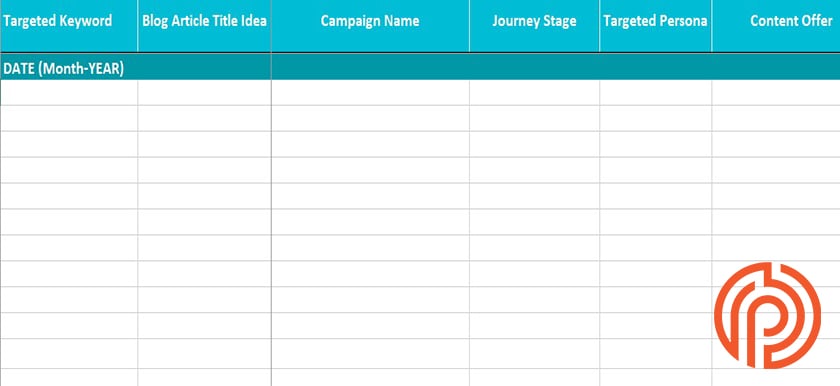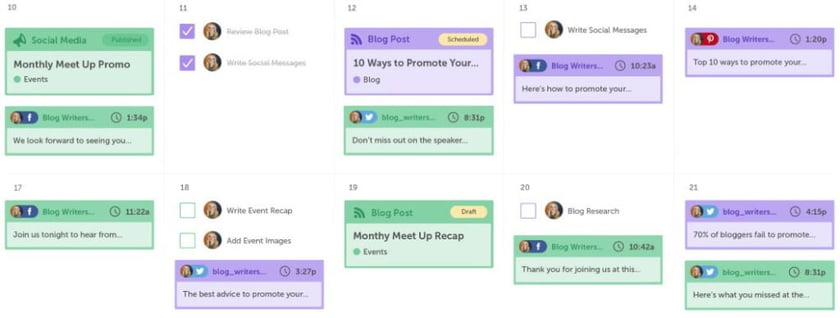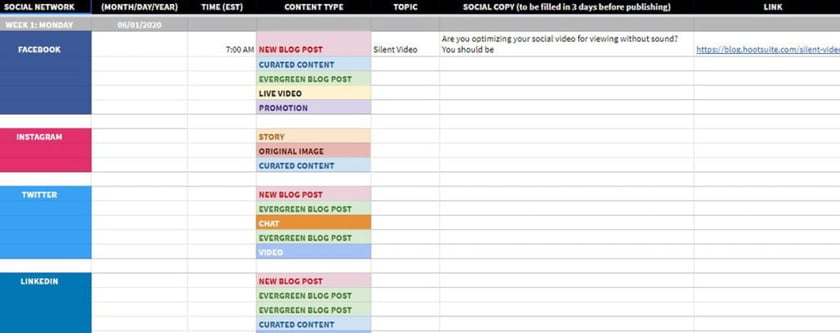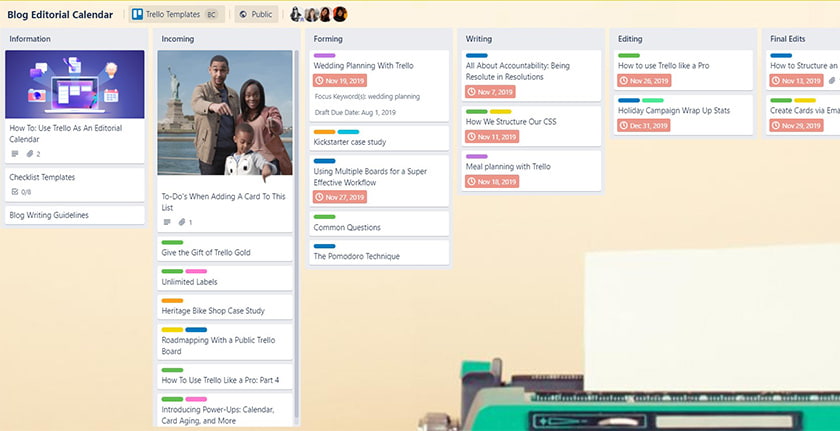Written By:
Will Purcell
When it comes to content marketing, organization is critical. That’s why an editorial calendar is absolutely essential for your content efforts. But where do you start? What examples should you follow to chart the best path forward?
We explore these questions in this article by highlighting:
-
A selection of editorial calendar templates
-
Examples of themes used for editorial calendars
-
How to choose the right template for your campaign
It’s no secret that adequate research is needed before launching a campaign or project. This is especially true for content creation. Fortunately, several guidelines, such as link building, technical seo, and persona creation are readily available to boost content marketing efforts and ROI.
But what about organization? Are there any “go-to” templates to include in your game plan?
The short answer is yes. However, it’s not that easy. We know that editorial calendars are vital to organizing content, but it’s unlikely you’ll be able to just randomly choose a template, plug in your content, and expect a successful campaign.
That’s because your campaign is unique, with different resources attached to each piece of content.
This is why it’s important to research as many templates as possible to find out what works best for your organization. To help narrow your search, we’ve provided some of our favorites below.
It’s important to note there’s no “one size fits all” when it comes to content creation, but these templates will help kick-start your research to find a platform that works for you.
Editorial Calendar Templates
Instead of posting a number of templates at random, we’ve provided a theme for each of these 5 examples to help structure your research and gameplan overall.
1. For SEO-Friendly Content Across Channels: Pepperland Marketing

Available as a free download, we’ve created an editorial calendar template that meets the needs of virtually any content marketing plan. This template downloads as an Excel document, however we recommend formatting this to Google Sheets because it resides in the cloud. This means multiple people within your organization can access and work within an up-to-date spreadsheet.
Free Download – Editorial Calendar Template
In this format, our editorial calendar can remain interchangeable to meet your unique content marketing needs. For instance, if your content includes podcasts, videos, or important social media messaging—this calendar has the capacity to cover those important deadlines and information.
We’ve also included columns with important terms and topics for search engine optimization. Each column header includes a brief description and explanation of what information should be included in the corresponding cells.

If you’re looking for the best materials to help your content rank well and grow your website, our editorial calendar template can help.
2. For Beginning Content Marketers: Hubspot

Hubspot’s free editorial calendar contains templates for both Mac and PC users. The zip drive download also offers flexibility with separate templates for Mac and PC users.
The design is effective because it highlights the key factors necessary for content creation. Information, such as deadlines, authors, keywords, and CTAs are provided in clear and concise column headers. This offers clarity when presenting content ideas to stakeholders and decision makers by providing them with a tangible plan of action for what a content plan should look like.
For organizations looking to move forward with a content marketing campaign for the first time, Hubspot’s easy-to-follow format can help.
3. For Calendar View: CoSchedule

CoSchedule is a comprehensive platform specializing in marketing organization. Prices fluctuate based on three different packages: Blog Calendar ($12 per user a month), Marketing Calendar ($22 per user a month), and Marketing Suite.
For content marketing purposes, the blog calendar provides automation tools for publishing and social messaging. Users can bulk schedule posts, or integrate their WordPress within the calendar as well. The marketing calendar provides sharing capabilities while the Marketing Suite contains 5 different products to help automate team workflows.
4. For Social Media: Hootsuite

Hootsuite offers a number of templates for content creators as well as educational courses to help organizations grow their marketing efforts. With an emphasis on social media marketing, Hootsuite offers four different packages with pricing ranging from $29 to $599 a month.
Efficiency is a key component of Hootsuite, as users can save time by creating, scheduling, and publishing messages across several social media platforms. Hootsuite software is also compatible with work tools, such as Slack, Salesforce, LinkedIn, and Adobe. If you’re looking for a comprehensive platform to grow your presence on social media, Hootsuite can help.
5. For Mobile Use: Trello

Trello is a free product management tool offering a colorful board for scheduling, publishing, and growing content.
Each board is tailored to the specific and unique needs of your organization. With real-time notifications and messaging, Trello’s “Teams” feature provides a strong communication system for any business, regardless of size.
Trello uses a colorful board system to assign and monitor tasks. Users can also edit calendar tasks on-the-go by downloading the Trello app for tablet and mobile devices.
Understanding Editorial Calendar Themes
So now that you have an idea of where to go for an editorial calendar template, how do you know which one is right for your organization?
To help narrow your search, we’ve placed some examples of commonly used editorial calendar themes. Keep these four examples in mind when creating an editorial calendar to get the most out of your content marketing campaign.
1. Standard, Deadline-Focused Calendar
At its core, a standard editorial calendar simply functions to keep all of your content in one place. With a focus on key dates, such as draft and publishing deadlines, this type of editorial calendar can bring some much-needed stability and structure to your content efforts overall.
With more of a focus on basic editorial practices, this calendar format could be helpful for first-time bloggers and content creators. In addition to keeping everyone on the same page, a standard editorial calendar can also provide a solid example of what a full content marketing campaign should look like. This is especially beneficial when it comes to presenting content ideas to stakeholders and business leaders because it provides a tangible, calculated, and transparent plan.
2. Social Media-Focused Calendar
Does this scenario sound familiar? Your company consistently delivers structured, detailed, and well-researched content. However, you start to notice your materials aren’t ranking as high as they should be. A greater push on social media can help, but when it comes to taking time to craft social messages, other tasks get in the way. As a result, your social messaging becomes overlooked and in most cases completely forgotten.
A social media calendar can help by alleviating any stresses or oversights involved with constant posting. In other words, your content marketing team becomes more proactive with content promotion. This benefits your company in a few ways:
- Outreach: Content is always paired with a social message, which creates another promotional tool for your organization.
- Site Strength: An increase in social media impressions usually leads to a boost in website traffic overall.
- Transparency: Content becomes easier to find, which can help facilitate prospects through the buyer’s journey.
Furthermore, maintaining a social schedule provides greater transparency with your campaign overall. For instance: What messaging worked? What didn’t? Where are the greatest opportunities for growth in outreach overall? A social calendar can help answer these questions.
3. Interview-Focused/Outreach-Based Calendar
Reaching out to subject matter experts is a great way to boost content. However, much like social media posting, without an organized plan, the process of scheduling interviews can become tedious and downright frustrating. That’s where an interview-focused editorial calendar can help.
For example, when it comes to scheduling content that uses interviews on a consistent basis, such as podcasts or vlogs, an interview-focused calendar can help facilitate the publishing process. That’s because each piece of content is paired with important information such as:
- Outreach deadlines for potential subject matter experts
- Interview dates and meeting links (if using virtual platforms like Zoom)
- Email templates for future outreach efforts
The more information you can provide concerning a scheduled interview, the better. And, using this calendar, you’ll eventually build a database full of subject matter experts, which will help strengthen your content and grow trust with your audience overall.
4. SEO-Friendly Calendar
Generally speaking, if you want your content to be effective, then it needs to be SEO friendly. This will ensure that it gets found organically through search engines like Google. When it comes to creating content that addresses common SEO strategies, an SEO driven editorial calendar is critical for success.
We’ve mentioned the generic categories associated with nearly every editorial calendar, but when it comes to SEO optimization, it’s best to keep these terms in mind:
- Keyword: The search term or phrase your optimizing content for
- Keyword Difficulty: A common metric used to asses how easy or difficult it will be for an article to rank on the first page of a search engine using that specific keyword.
- Volume: Highlights the number of searches expected for a keyword or search query.
- Traffic Potential: The potential amount of visitors a page could receive if the article ranks highly within a search engine like Google.
- SERP: The “Search Engine Results Page” or SERP provides a view of how your content will look when typing it’s associated keyword or article title into a search engine.
- Meta Description: A meta description provides a brief summary of a page’s purpose for search engines to review when ranking relevant topics for certain queries.
- Title Tag: Similar to an article’s main header, a title tag represents the page’s title, only this title will appear on browser tabs and as headlines on search results.
By using an SEO driven editorial calendar, you can ensure these terms are incorporated into every stage of the content creation process from initial brainstorm sessions to post-publishing promotion.
Create an Editorial Calendar that’s Right for You
As you can see, there are many formats to consider when selecting the right template for your editorial calendar. The important thing to remember is that your editorial calendar should address the specific needs of your content.
Without a structure in place, achieving your content marketing goals will become more difficult and in some cases, unobtainable. Fortunately, however, help is available to ensure your content marketing campaign is organized, calculated, and optimized for success.
Not sure where to start? Contact us at Pepperland Marketing to review your content goals and design a strategy built for success!








